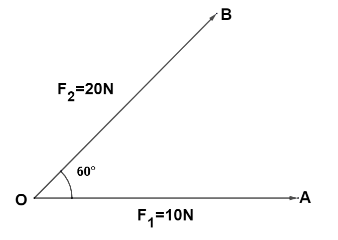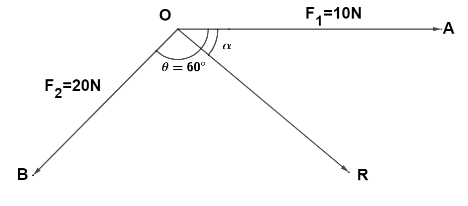
If ${F_1} = 10N$ , and ${F_2} = 20N$ , find ${F_2} - {F_1}$ and $\tan \alpha $.


Answer
396.6k+ views
Hint:To find the resultant of the two vectors and angle between the resultant vector and initial vector, we use the concept of Subtraction of two vectors. The direction of the resultant vector is given by the angle $\alpha $ between resultant and ${F_1}$.
Complete step by step answer:
We know that, The magnitude of the resultant vector $R = {F_2} - {F_1}$ is given by
\[R = {F_2} - {F_1} = \sqrt {F_1^2 + F_2^2 - 2{F_1}{F_2}\cos \theta } \]
Where, $\theta $ is the angle between ${F_1}$ & ${F_2}$
\[\Rightarrow R = {F_2} - {F_1} = \sqrt {{{10}^2} + {{20}^2} - \left( {2 \times 10 \times 20} \right)\cos {{60}^ \circ }} \]
Solving,
\[\Rightarrow R = {F_2} - {F_1} = \sqrt {500 - \left( {400} \right) \times \dfrac{1}{2}} \]
\[\therefore R = {F_2} - {F_1} = \sqrt {500 - 200} = \sqrt {300} \]
We get , \[\therefore {F_2} - {F_1} = 10\sqrt 3 N\]
Now, direction of resultant vector is given by

\[\tan \alpha = \dfrac{{{F_2}\sin \theta }}{{{F_1} - {F_2}\cos \theta }}\]
Substituting the values, we have
\[\tan \alpha = \dfrac{{20\sin {{60}^ \circ }}}{{10 - 20\cos {{60}^ \circ }}}\]
\[\therefore \tan \alpha = \dfrac{{20\left( {\dfrac{{\sqrt 3 }}{2}} \right)}}{{10 - 20\left( {\dfrac{1}{2}} \right)}}\]
We get, \[\tan \alpha = \infty \]
So, \[\alpha = {90^ \circ }\] as $\tan {90^ \circ }$ is not defined at $\infty $ .
Hence, \[{F_2} - {F_1} = 10\sqrt 3 N\] and \[\tan \alpha = \infty \].
Note: The value of the angle in the question is the angle between two vectors and we are asked to find the value of the angle between resultant and the first force vector. From the calculation, it is cleared that the angle between the resultant and the vector is the right angle.
Complete step by step answer:
We know that, The magnitude of the resultant vector $R = {F_2} - {F_1}$ is given by
\[R = {F_2} - {F_1} = \sqrt {F_1^2 + F_2^2 - 2{F_1}{F_2}\cos \theta } \]
Where, $\theta $ is the angle between ${F_1}$ & ${F_2}$
\[\Rightarrow R = {F_2} - {F_1} = \sqrt {{{10}^2} + {{20}^2} - \left( {2 \times 10 \times 20} \right)\cos {{60}^ \circ }} \]
Solving,
\[\Rightarrow R = {F_2} - {F_1} = \sqrt {500 - \left( {400} \right) \times \dfrac{1}{2}} \]
\[\therefore R = {F_2} - {F_1} = \sqrt {500 - 200} = \sqrt {300} \]
We get , \[\therefore {F_2} - {F_1} = 10\sqrt 3 N\]
Now, direction of resultant vector is given by

\[\tan \alpha = \dfrac{{{F_2}\sin \theta }}{{{F_1} - {F_2}\cos \theta }}\]
Substituting the values, we have
\[\tan \alpha = \dfrac{{20\sin {{60}^ \circ }}}{{10 - 20\cos {{60}^ \circ }}}\]
\[\therefore \tan \alpha = \dfrac{{20\left( {\dfrac{{\sqrt 3 }}{2}} \right)}}{{10 - 20\left( {\dfrac{1}{2}} \right)}}\]
We get, \[\tan \alpha = \infty \]
So, \[\alpha = {90^ \circ }\] as $\tan {90^ \circ }$ is not defined at $\infty $ .
Hence, \[{F_2} - {F_1} = 10\sqrt 3 N\] and \[\tan \alpha = \infty \].
Note: The value of the angle in the question is the angle between two vectors and we are asked to find the value of the angle between resultant and the first force vector. From the calculation, it is cleared that the angle between the resultant and the vector is the right angle.
Recently Updated Pages
One difference between a Formal Letter and an informal class null english null

Can anyone list 10 advantages and disadvantages of friction

What are the Components of Financial System?

How do you arrange NH4 + BF3 H2O C2H2 in increasing class 11 chemistry CBSE

Is H mCT and q mCT the same thing If so which is more class 11 chemistry CBSE

What are the possible quantum number for the last outermost class 11 chemistry CBSE

Trending doubts
The reservoir of dam is called Govind Sagar A Jayakwadi class 11 social science CBSE

What is the chemical name of Iron class 11 chemistry CBSE

The dimensional formula of dielectric strength A M1L1T2Q class 11 physics CBSE

The members of the Municipal Corporation are elected class 11 social science CBSE

What is spore formation class 11 biology CBSE

In China rose the flowers are A Zygomorphic epigynous class 11 biology CBSE




